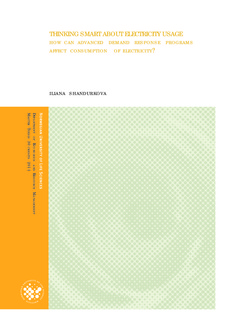| dc.contributor.author | Shandurkova, Iliana | |
| dc.date.accessioned | 2011-10-24T13:07:41Z | |
| dc.date.available | 2011-10-24T13:07:41Z | |
| dc.date.issued | 2011-10-24 | |
| dc.identifier.uri | http://hdl.handle.net/11250/187263 | |
| dc.description.abstract | Recent developments in the Nordic power system have shown some negative trends that relate to all actors in the market. Overall increase in prices and periods with extremely high prices are observed and operational problems are encountered. These facts question the reliability and security of electricity supply and challenge the development of a smarter grid through which problems can be mitigated. Facing the situation described above the Norwegian Government has decided that advanced metering system (AMS) will be installed everywhere in the country by 2016. A main idea behind this action will be to stimulate energy savings and increase consumers’ knowledge on their electricity usage. The desired consequence of the installation, however, will be to open possibilities for demand response (change in consumers’ electricity usage patterns in response to price). This increased demand responsiveness can be a good solution to the existing operational problems. This thesis analyzes the effect of a demand response program that involves time-of-use pricing and remote load control of household heating equipment and sets the analysis in the general concept of efficiency in the electricity market and all the benefits associated with it. The main focus has been to estimate the influence that automatic steering of waterborne space heating and electrical water heaters in combination with a tariff compiled of peak, off-peak and spot prices will have on Norwegian households’ electricity usage based on a pilot testing remotely controlled load shifting at Malvik Everk. For this purpose I have used econometrics to estimate substitution elasticity and a price-elasticity equivalent measure and have tried to compare the extent to which electricity consumption has been reduced and moved to other periods throughout the day.
The estimation of substitution elasticity does not provide any statistically significant proof of shift from peak to off-peak usage as a response to prices charged. These results indicate that load reduction should be attributed specifically to RLC and not to price changes as prices and usage do not follow a particular correlation pattern during the hours neighboring the predefined peak periods. Price elasticity’s estimates prove to be highly significant and show that load during hours of RLC has been reduced simultaneously with the customers being charged peak prices. The resulting elasticities equal to -0.47 and -0.10 account for a much higher extent of price-responsive behavior as compared to previous studies that analyzed price elasticities. Results from demand response based pilots such as the one at Malvik Everk provide some important insights on what the opportunities for demand curtailment can be and on how load can be rescheduled. Estimation results indicate a big potential for RLC to contribute for reduction of consumption during hours corresponding with high-price periods. However, the true success of demand response programs will depend mainly on the introduction of adequate technological solutions, correct electricity pricing methods and a sound knowledge of the desired effects and their consequences. | en_US |
| dc.language.iso | eng | en_US |
| dc.subject | demand response | en_US |
| dc.subject | electricity supplies | en_US |
| dc.subject | hydro electric power | en_US |
| dc.subject | prices | en_US |
| dc.subject | households | en_US |
| dc.subject | energy consumption | en_US |
| dc.subject | Norway | en_US |
| dc.title | Thinking smart about electricity usage : How can advanced demand response programs affect consumption of electricity? | en_US |
| dc.title.alternative | Tenke smart om strømforbruk : Hvordan kan avanserte programmer for forbrukerfleksibilitet påvirke forbruk av elektrisitet? | en_US |
| dc.type | Master thesis | en_US |
| dc.subject.nsi | VDP::Technology: 500::Electrotechnical disciplines: 540::Electrical power engineering: 542 | en_US |
| dc.subject.nsi | VDP::Social science: 200::Economics: 210::Economics: 212 | en_US |
| dc.source.pagenumber | 59 | en_US |
